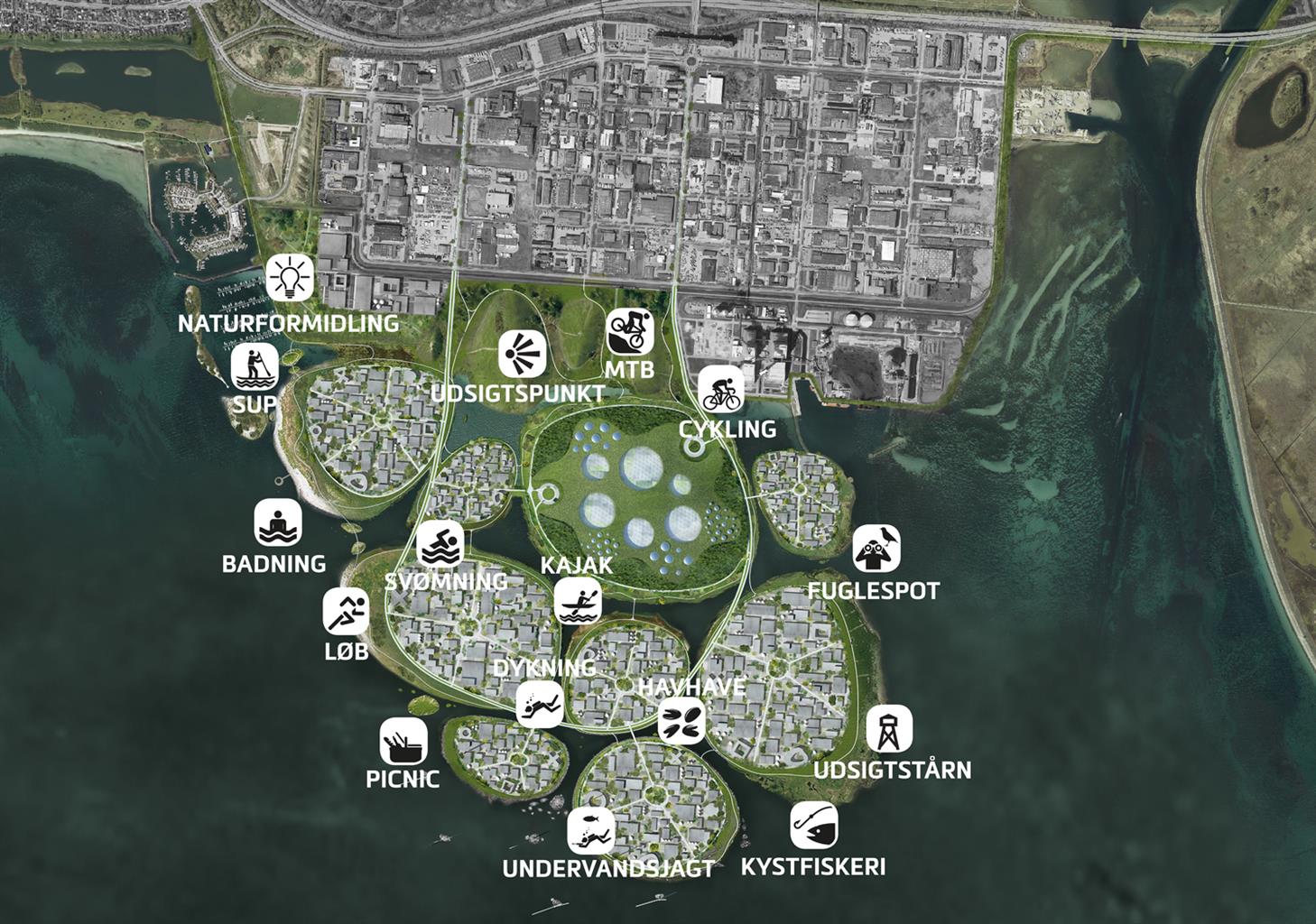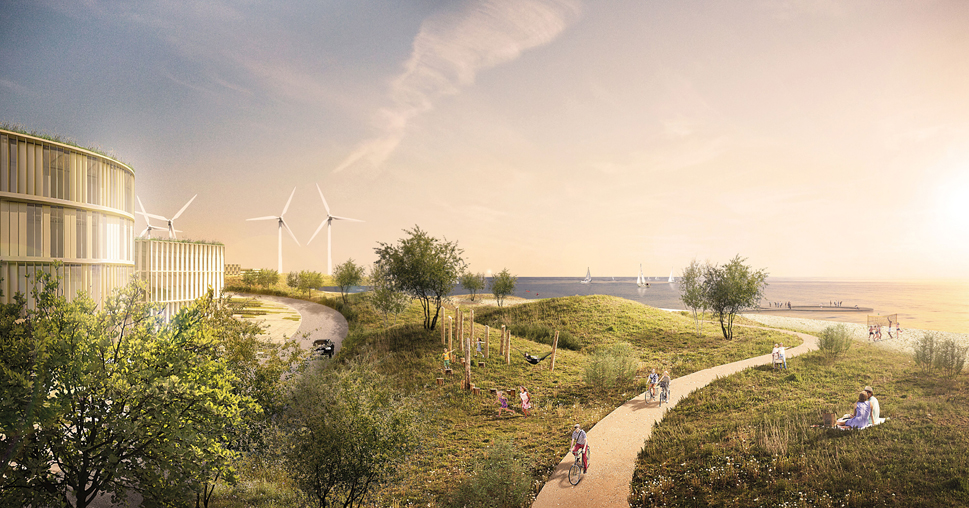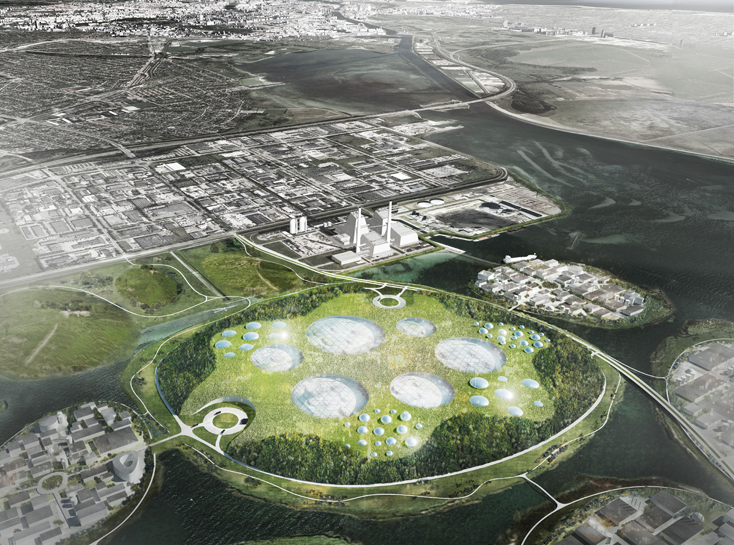
- Sustainable Planet -
- 6mins -
- 1,089 views
Denmark set to create 9 renewable energy-producing islands outside Copenhagen
Danish Government unveils plans for one of Northern Europe’s largest, greenest and most innovative business districts.
Copenhagen plans one of Northern Europe’s largest, greenest and most innovative business districts
In a push to bring more clean energy to the city of Copenhagen, the Danish government has announced plans to build nine new artificial islands as part of what will become the largest and most ambitious land reclamation project in Scandinavia. Set to begin construction in 2022, the project, dubbed Holmene (the Islets), will comprise 3 million square meters of land and will be located just 10 kilometers south of Copenhagen.
Copenhagen-based architecture and planning firm URBAN POWER designed the project with environmentally friendly targets in mind, from the creation of the biggest waste-to-energy plant in Northern Europe to improved biodiversity.
Holmene to be a “growth engine” for all of Denmark
The Danish Government and Mayors of Greater Copenhagen have announced plans for the 3 million sqm land reclamation project. The vision, designed by URBAN POWER architecture & planning, deals with urgent environmental and commercial challenges of the metropolitan area.
The nine Islands, called Holmene (the Islets), located just 10 km south of Copenhagen, is currently the largest land reclamation project in Scandinavia. They address several needs in the area: A growing demand for sites for knowledge-intensive industry, fossil-free energy production, and a flood barrier to secure both existing and future areas. Furthermore it adds an enormous public accessible natural area for sports, recreation and improved biodiversity.
According to analyses conducted by Deloitte and jointly by COWI, Urban Power and DHI, Holmene will contribute:
- A 3.1 million square metre green business district
- New growth – up to DKK 54 billion
- Space for up to 380 new businesses
- 700,000 square metres of new nature areas in an urban location
- 17 km new coastline
- Up to 12,000 new jobs

FOSSIL FREE ENERGY FROM COPENHAGENERS WASTE
An essential part of the land reclamation, URBAN POWER designed an area reserved for green technologies and the biggest Waste-to-Energy plant in Northern Europe. Bio waste and waste water from the regions 1.5 million citizens, is handled here and turned into clean water, resources and biogas.
Together with heat storage, wind mills and other green technologies, an annual reduction of at least 70.000 tons CO2 and production of more than 300.000 MWh fossil free energy: Equivalent to the power consumption of 25% of the population of Copenhagen city. An important step towards the green transition.
Source: UrbanPower

RESILIENT GREEN DELTA
The high level of ambition lead to the involvement of URBAN POWER. Their strategic design introduced a group of islands rather than a traditional massive land reclamation.
“The strategy has several advantages: It can be developed stepwise without leaving the impression of an unfinished project, if a new economic recession appear. Furthermore the islands can be thematically developed, leaving the best conditions for the innovative industry and research within green tech, bio tech, life science and future yet unknown sectors”, says Arne Cermak Nielsen, partner of URBAN POWER.
He adds: “The quality of being by the water should not be underestimated, and the shores of the islands and the delta that emerge between them has a unique potential”.
As a result each island will have a green belt of nature, that ensures attractive transitions between land and water. The diverse landscape invite for sports and activities in some areas and recreation in others. There’s even several small islets and reefs inaccessible for humans, to provide the best conditions for nature and wildlife at land as well as in the water.
Surplus soil is the backbone of the land fill. It financed the construction of the islands and solves an urgent challenge of surplus soil from the region’s subway and building projects. The soil will additionally be used to create a natural protective landscape along the existing coastline: It makes the landscape resilient towards future floodings and provides an improved network of 18 km bike routes i green surroundings.
Source: UrbanPower

Green Tech Island will make Denmarks’s capital greener
One of the nine islets will be green. At Green Tech Island, wastewater from the residents and businesses of Greater Copenhagen will be transformed into clean water.
Green Tech Island is one of the nine planned islets. It will help to make Denmark’s capital one of the world’s greenest. It is a place where the things people dispose of can be used to produce green energy and resources that we need.
A place where wastewater from the residents and businesses of Greater Copenhagen will be transformed into clean water. Where sludge and bio-waste can be converted into sustainable biogas.
Where they can store surplus green energy from wind turbines, for use on wind-free days. And a place where new technologies can be tested, catapulting Denmark to the forefront of the world elite in smart energy utilisation and production.
Source: Holmene.com

FACTS AND STATS ABOUT THE HOLMENE PROJECT
THE PROCESS
- URBAN POWER architecture & planning has developed the strategic design of Holmene
- It’s the largest and most ambitious land reclamation area of Scandinavia in the years to come
- The environmental impact assessment starts in 2019
- Construction starts in 2022
- Project is expected to be completed in 2040
COWI is the consulting engineer on construction, cost, environmental impact etc. Additional advising by DHI-group, MOE, Aglaja and Rambøll
SIZE
- 9 islands with industry and accessible natural areal for sports and recreation
- Several inaccessible islets and reefs for untouched nature
- 2,3 million square meter industrial area (apx 24 mio sqf)
- 0,7 million square meter natural areas
- Constructed by 26 million cubic meter of surplus soil
ECONOMY
- Income from surplus soil and sale of plots, 480-540 million euro
- Construction cost, expected 425 million euro
- Estimated 380 new businesses and 12000 jobs
- BNP growth, up to 7 billion euro
FOSSIL-FREE ENERGY PRODUCTION
- Expected annual production of 322.000 MW fossil free energy
- Expected 74.000 t of annual CO2 reduction compared with danish energy-mix
- Expected 278.000 t of annual CO2 reduction compared with energy from coal
The environmental impact assessment starts in 2019 and the project is slated for completion in 2040.
Source: UrbanPower

